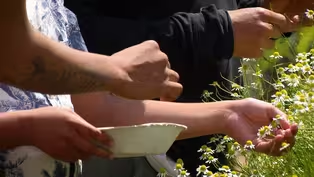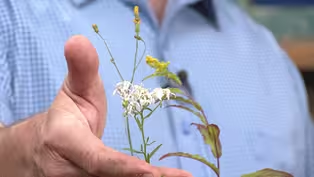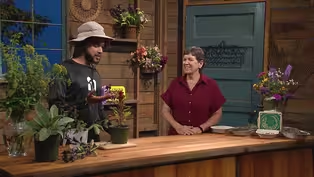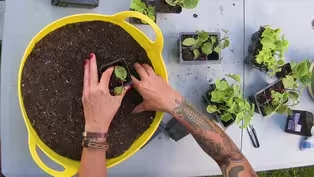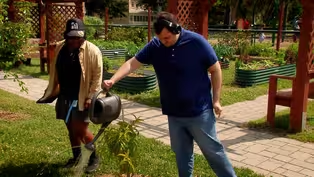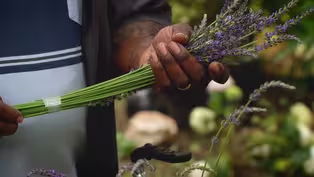Virginia Home Grown
The Healing Power of Nature
Clip: Season 23 Episode 4 | 8m 12sVideo has Closed Captions
Learn how healthy ecosystems benefit humans
Peggy Singlemann visits restoration ecologist Charles Smith at an old growth forest in Spotsylvania to discuss how healthy forests and ecosystems improve human health and mental well-being. Featured on VHG episode 2304; June 2023.
Problems playing video? | Closed Captioning Feedback
Problems playing video? | Closed Captioning Feedback
Virginia Home Grown is a local public television program presented by VPM
Virginia Home Grown
The Healing Power of Nature
Clip: Season 23 Episode 4 | 8m 12sVideo has Closed Captions
Peggy Singlemann visits restoration ecologist Charles Smith at an old growth forest in Spotsylvania to discuss how healthy forests and ecosystems improve human health and mental well-being. Featured on VHG episode 2304; June 2023.
Problems playing video? | Closed Captioning Feedback
How to Watch Virginia Home Grown
Virginia Home Grown is available to stream on pbs.org and the free PBS App, available on iPhone, Apple TV, Android TV, Android smartphones, Amazon Fire TV, Amazon Fire Tablet, Roku, Samsung Smart TV, and Vizio.
Providing Support for PBS.org
Learn Moreabout PBS online sponsorship>>It's just so relaxing to be in these woods.
It just makes me feel so much better.
So tell me about this lovely forest we're standing in.
>>Well, this is a little bit older piece of woods.
I think that's the key, is that the quality of a resource, a natural area, has a lot to do with how long it's been left alone.
The more disturbance, the lower the quality of the resource.
So this one is an older piece of woods.
Definitely the soils are greater than 80 to 100 years or so old, well, since people have done any real disturbing activity.
>>You know, when most people think of a forest, they just think of the trees and the understory plants.
But there's so much more to a forest than that.
>>Yes, it is diversity in not only the types of species, but how they interact with one another, how they're kind of arranged on the landscape.
They layer above ground and they actually layer below ground.
It's that soil profile that's actually one of the most important parts for forest health, or almost any good ecosystem.
You cannot replace a healthy forest soil in a human lifetime.
Not only do plants share the soil profile, they actually feed the soil profile.
They pump their sugars, what are called root exudates, actually feeds the soil, and it feeds all the organisms in return.
They get the benefits of nutrients they couldn't otherwise get from bacteria and fungus.
So it's really this incredible interaction above and below ground.
>>That's amazing.
The two are just symbiotic.
>>And the irony is the smell of good dirt is a geosmin.
It actually comes from bacteria.
>>Oh, really?
>>And so when you smell dirt has that really rich smell, that's just lots of bacteria.
>>Oh, that's cool.
>>Yeah, that's usually in highly organic soil.
>>Mm-hm.
So when I walk into a, I'll say a dense woodland, a healthy woodland area, there is a smell, there's a fragrance to it.
Where does that come from?
>>Well, the plants are releasing compounds, and there are volatile organic compounds.
And there's really good studies have been done in the last 10 years that show the definitive benefits of being in a healthy natural system.
Almost anything outside can be beneficial to you.
It's understood that gardening is very beneficial to you.
But the richer and the healthier the ecosystem, the more it provides those benefits to you.
And they think it's several different things.
One is psychological, that there's the concept of biophilia, that we evolved here and that that is something that we naturally gravitate towards is healthy land systems.
But in addition, they produce chemicals that we're breathing that are actually helping our autoimmune system and they're just overall beneficial for our mental and physical health.
>>How large of an area of forested land is needed to really help benefit not only the ecosystem, but also us as humans?
>>It can be small, and right now, I mean, we're standing in a woods that's on a property that's not very big.
We're near a major road.
There is a materials business close by, so you hear dump trucks during the day.
But the bottom line is because you've got all the habitat pieces, the wildlife's happy here.
So it's functioning.
It's got some buffers that are depleted, but that landscape mosaic is often what you're looking for.
It's different pieces of habitat across the landscape complementing one another, but it doesn't have to be that big.
And I worked in park systems for years and there are postage stamps parks and little community areas that are relatively good quality that can provide a lot of good benefit.
Now of course, the bigger it is, usually the better it is in terms of the overall species diversity and abundance as well as all the ecosystem functions.
But it doesn't have to be that big.
>>My husband and I, we go to the mountains regularly to get our forest fix.
So what other places could we go to to get those benefits that just make us feel so much better?
>>It doesn't just have to be a forest for benefits.
It can be an area near water, which is the reason why people love the beach so much.
It can be meadow areas.
It can be high mountain areas.
It can be deserts.
It just has to have all the components.
It's the less disturbed systems that have the better benefits for us.
We've altered 77% of the habitable Earth.
So it's those few fragments with healthy soil profiles that have the greatest biodiversity, both in what's living under the ground and above the ground.
It's all those pieces working together that, again, produce more compounds and greater benefits for us as well as overall ecosystem benefits.
Healthy systems, you should see leaves.
You shouldn't see green all over the ground, unless maybe you're in a low area with a fern stand.
You know, but other than that, you should not see green everywhere.
You should see layers.
Those layers shouldn't be green in the winter, except unless they're may be something like a mountain laurel.
>>Or a bayberry.
>>Or bayberry, something that's an evergreen.
But the vast majority of vegetation should defoliate in the winter.
And then of course, the other thing, I mentioned deer.
Deer vacuum our forests clean.
>>Oh, gosh yes.
>>So where they're massively overabundant, they lower biodiversity.
And the other thing to remember, I think one of the common denominators people love, butterflies and birds.
Well, butterflies, a significant percentage, spend three stages of their lifecycle in the forest.
They eat tree leaves, then they go into pupal stage in the leaves in the ground, and then they emerge, of course, as an adult.
But only then do they go to your garden or a butterfly, you know, habitat that you see with wildflowers.
Similarly with birds, this time of year, they are feeding their young caterpillars.
And so you have to have a healthy forest in order to have native birds and it's critical because there can be over a million caterpillars eaten in a square mile per day of forest by birds raising their young.
It's amazing.
>>And it's so important, we as a community need to focus on increasing the number of native plants in our landscapes.
>>Yeah, native plant biomass is critical.
It's that ability of insects to eat the native plants.
It's not just providing nectar from a flower.
It's actually eating the plant itself, feeding off the roots, feeding off the stems, feeding off the leaves.
It's those co-evolved relationships between insects.
Non-natives are not problematic in the sense that it's wonderful to have beautiful plants you enjoy.
It's when they are too much of the landscape and/or they're invasive and they start to take over and crowd everything else.
>>Exactly.
>>Yeah, it's that lack of native plant biomass that we're really struggling with right now.
>>And I think people need to realize too, not having perfect plants.
We're allowed to have plants with holes in them.
>>Yes.
>>We're allowed to have plants be eaten.
And I think some people don't realize that even for trees, when it gets to late summer, early autumn, yes, those leaves need to be eaten by the insects so that they can continue with their lifecycles and the tree is done, I'll say done its thing for the tree and it has a natural cycle within itself to be able to preserve and conserve its resources for the winter, knowing that the leaves now are going to be used for insect food so that it's that circle of life, shall we say?
>>Well, the irony is that a healthy forest, when you're walking through it, you don't realize there are millions of caterpillars eating that forest every second of the growing season, but they're not harming it because, again, they co-evolved.
It's that balance, because there's tons of predators eating those insects also.
So again, that interrelationship co-evolved over millions and tens of millions of years is really the key.
>>And I think we can get it back.
It's not going to happen overnight.
But I think if we can start changing our thinking and think and understand the relationship of our landscapes to our natural forests, then I think we can do it.
>>I've worked a lot with Audubon Society, and they're really big on promoting backyard habitat and certified landscapes.
And one of the things I think that's really good is say to people just plant a mailbox garden, 10 by 10, 5 by 8.
>>Start somewhere.
>>Whatever it is, just start.
Get some native plants in there.
Get some funky ones in there.
Oh, the other thing, of course, is multiple lifecycle stages.
So you've got most of our bees, 70% of our bees nest in the ground.
They've got to have leaf litter.
They've got to have woody debris.
They don't go into a place that you would assume is like where they go.
They actually nest in the ground.
So having that just good soil profile is critical for the most important pollinator, which is bees.
>>Yes, and not our European honeybee, but our native bees.
>>Yeah, our 4,000 species of native bees, wasps, and others.
>>Here in the United States.
Yes, yes.
>>Yeah.
>>We all can play a part in reconnecting things.
And I really thank you for explaining it to us.
>>Absolutely, I really appreciate it because I know that it takes a lot of us to make a difference.
Although, each one of us can do something, and of course, we get direct benefits from all that we do individually and collectively.
>>Absolutely.
Clippings: Connecting with Nature
Video has Closed Captions
Clip: S23 Ep4 | 26m 46s | Discover connections between nature and our well-being! (26m 46s)
Native Plants for Healthy Forests
Video has Closed Captions
Clip: S23 Ep4 | 6m 18s | Support birds and insects with native plants (6m 18s)
Video has Closed Captions
Clip: S23 Ep4 | 5m 45s | Herbs and sensory garden plants (5m 45s)
Video has Closed Captions
Clip: S23 Ep4 | 3m | Grow strong seedlings with the right size pots (3m)
Video has Closed Captions
Clip: S23 Ep4 | 8m 28s | Gardening therapy for children with special needs (8m 28s)
Video has Closed Captions
Clip: S23 Ep4 | 3m 3s | Preserve lavender for the scent and taste (3m 3s)
Providing Support for PBS.org
Learn Moreabout PBS online sponsorship

- Home and How To

Hit the road in a classic car for a tour through Great Britain with two antiques experts.












Support for PBS provided by:
Virginia Home Grown is a local public television program presented by VPM
